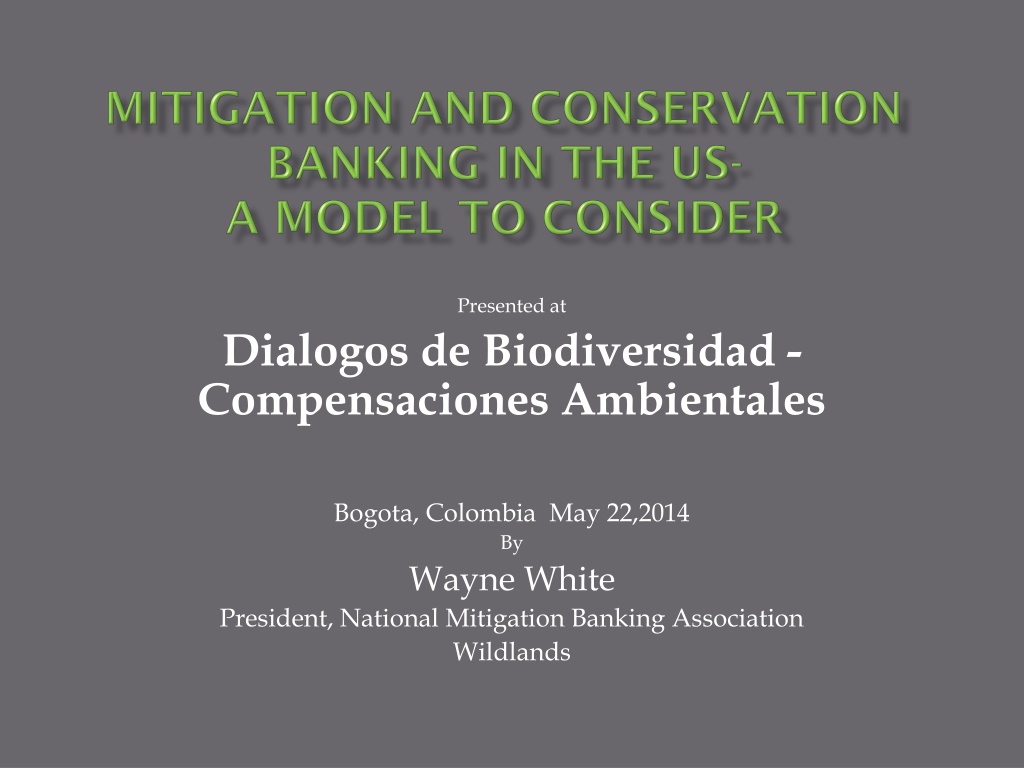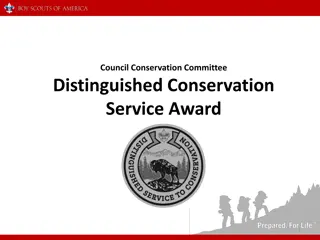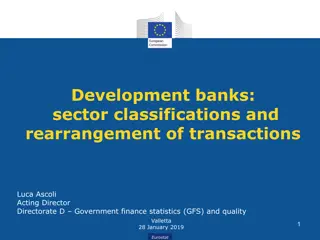Mitigation and Conservation Banks: A Comprehensive Overview
This content presents insights from Wayne White, President of the National Mitigation Banking Association, regarding the concept of mitigation/conservation banks, their evolution, benefits, agency requirements, and the principles behind their establishment. It emphasizes the importance of market-driven wetland mitigation banking programs and outlines the key role these banks play in offsetting environmental impacts. The content also discusses the regulatory frameworks governing mitigation banks and their significance in conserving natural resources for at-risk species.
Download Presentation

Please find below an Image/Link to download the presentation.
The content on the website is provided AS IS for your information and personal use only. It may not be sold, licensed, or shared on other websites without obtaining consent from the author. Download presentation by click this link. If you encounter any issues during the download, it is possible that the publisher has removed the file from their server.
E N D
Presentation Transcript
Presented at Dialogos de Biodiversidad - Compensaciones Ambientales Bogota, Colombia May 22,2014 By Wayne White President, National Mitigation Banking Association Wildlands
o Mitigation Implementation o Hierarchy o Avoid o Minimize o Mitigate unavoidable, residual impacts o Compensatory Mitigation o Permittee responsible mitigation o In lieu fee program o Banks
o The experience and scientific expertise of the NRC study panel s most important finding was that the market-driven, incentive-based wetland mitigation banking program had outperformed both in-lieu fee mitigation and permittee-responsible mitigation o No Equivalency Standard
What is a mitigation/conservation bank? o Regulations require mitigation/offsets o Evolution of US banking o Benefits of banks- o Agency requirements for bank approval o Service area and credits o Offsets around the world o Key messages o Principles of mitigation and recommendations o
A site or suite of sites containing natural resource values that are conserved and managed in perpetuity for specified listed or other at-risk species and used to offset impacts occurring elsewhere to the same type of resource. o Pre-approved Net Conservation Benefit Offset Unavoidable Impacts
Market-based 3rdparty System Agency Agency Agency Tribes Local Gov t Review Team Agency Agency Agency Scientific Community Bank Bank Bank Broker Bank Sponsor Buyer Buyer Banker Banker Buyer Land- owner Land Mgr CE Holder $ Holder
Federal Government o Clean Water Act- Sec 404 o (No-net loss: Mitigation banks) o Endangered Species Act- Sec 7 o (BO s: Conservation banks) o Natural Resource Damage Assessment (Restoration to offset impacts) State and local Governments o Varies- water, protected species and natural resources
Clean Water Act 1972 Endangered Species Act 1973 Restore and maintain the chemical, physical, and biological integrity of the Nation s waters. provide a means whereby the ecosystems upon which endangered and threatened species depend may be conserved No Net Loss Policy (1989) Unlawful to take Permit from USACE or State Avoid, Minimize, Compensate impacts Permit from FWS or NMFS Avoid, Minimize, Mitigate impacts Compensatory Mitigation: Bank over In-Lieu fee over PRM Compensatory Mitigation: No clear mitigation type preference No overall mitigation policy Depends on species needs Clear policy regulation over time Creation/Restoration over Preservation
1972 Clean Water Act and Endangered Species Act Required permit to fill wetlands 1973 Endangered Species Act Prohibited take of listed species Both Acts require offsets but no directive or cookbook on how to NO MITIGATION POLICY
10 years later FWS memo recognizing mitigation banking 12 years later First wetland mitigation bank approved 17 years later No net loss policy but no guidance 19 years later First conservation bank established
23 years later Federal Guidance on Establishment Mitigation Banks 30 years later FWS Guidance (Policy) for Conservation Banks 36 years later New Wetland Mitigation Rule 41 years later FWS Developing mitigation policy for all authorities
o Biodiversity further reduced- low quality offsets not meeting ecology goals o More endangered species- further loss of habitat o Greater conflict between project and biodiversity over time o More polarization and activist groups o Project planning lack guidance for designing offsets; increasing permitting time o Increasing costs
Economies of Scale Biological Benefits Aid in recovery (outcome-based & traceable) Preserve ecosystems Avoid piecemeal mitigation & temporal habitat losses Contributes to conservation strategies; science Vernal Pool Tadpole Shrimp Business Benefits Streamlined permit/mitigation process Transfer of liability Provides assurances (mgmt, financial) Reduce agency time monitoring mitigation sites Reduce need for enforcement For-profit conservation
o Private sector investment to conserve habitat not consume habitat- For profit investment to conservation biodiversity! o Provides potential new economic engine for private landowner who want to maintain ownership o Assist implementation of regional conservation planning efforts and recovery of endangered species o Severance of liability
Process procedures timelines Biological Legal/Real Estate Financial CBA the legal document for the establishment, operation and use of a conservation bank Perpetual Conservation Easement (or alternative for public lands) Financial mechanism sufficient to fund long- term management, monitoring and reporting (non-wasting endowment preferred) Long-term Management Plan with Performance Standards, Monitoring, etc.
Conservation strategy Mitigation/Service Area = the geographic area within which offsets can occur o Defined by the Agencies o Based on the conservation needs of the species:
Simplify Credits Credits = Surrogate Measures for Recovery Hectares/ Meters 1000 hectares habitat 1 = credit 1 Individuals 1 = credit pair o r or Time-Based? Weighted Function 1 Salmon Credit (Sc) Equation ( * Lnb S = credit ( ) ( ( ) 5 . 0 * ) ) ( ) + * S Lpb = Sc fp fp
o Australia- 1) NSW Biobanking in 1995 law. Mixed results; 450 hectares conserved so far; 2) Victoria BushBroker. Uses Habitat Hectare metric, market place for developers and landowners; mostly successful o UK- Biodiversity Offsetting in England 9/13 o Germany- ILF to local jurisdictions may lack in- kind offsets plus true cost to mitigate questionable o India- Some legislative policy but lacks clarity and guidance; not successful o Chile- Legislation requiring offsets; developing processes and policies
o Habitat Banking in Latin America and Caribbean- A Feasibility Assessment- specific discussion of potential market in Colombia o Business and Biodiversity Offset Program- providing mitigation hierarchy with an emphasis on biodiversity offset guidance and standards consideration for corporations and governments
Species Conservation Strategy o Compensatory mitigation should be based on a larger landscape conservation strategy for the species and lead towards a net conservation benefit. Must develop Compensatory Mitigation policy o Have one standard for compensatory mitigation and implement it consistently for all forms of mitigation. Use mitigation plans and programmatic agreements when possible. Distance from Impact Site and Credit Methodologies o Careful selection of distance from impact site (or service areas for banks) and simple credit methodologies based on balance between needs of species and mitigation program. Program Process/Timelines o Policy or guidance on how the compensatory mitigation will operate, education of personnel, legal review, templates, tracking, etc. o o o o
o Assure appropriate offsets are implemented that benefit the conservation of species and habitat o Provide a strong biological, financial and legal framework for offsets to persist for the length of the impact consistently o Landscape scale implementation o Communicate to all stakeholders the basic provisions expected of them in any situation where mitigation is required.
o Mitigation projects must contain strong performance assurances that restoration, enhancement, creation or preservation activities will be completed as required in perpetuity. This would include a mix of legal and economic assurances including support for the premise that mitigation done in advance of impacts is preferable to mitigation done after the fact.
o Standards and metrics should be used consistently for permits involving mitigation. These standards and metrics should apply for permanent or temporary impacts . Metrics should provide meaningful information about particular species and habitat characteristics. Standards must also insure measurable and lasting benefit using the same ecological criteria and metric that are used to measure impacts.
o Offset proposals should take into account large scale conservation strategies. High priority habitats should be protected using the mitigation hierarchy- avoid, minimize then mitigate residue, unavoidable impacts. Low priority habitat less avoidance. Like-for-like offsets or trading up when fully justified.
o Review existing regulatory framework o Establish policy and regulatory foundation with clearly defined processes (scientific, legal and financial) and timelines o Integrating with existing permitting processes o Build capacity to implement mitigation policy o Equivalency for types of mitigation banks, in lieu fee. permittee responsible o Strive for high standards o Preference for banks over in lieu fee or permittee responsible mitigation supported by US studies o Minimize the number of agencies
Legal o Offsetting measures will guarantee the effective conservation or ecological restoration of an equivalent ecological area, where it is possible to generate a new management category, a permanent conservation strategy or where the biodiversity conditions are improved in areas that have been negatively transformed or subject to transformation processes.
Scientific o To qualify must address three fundamental aspects: o a) How much to offset in terms of area o b) Where the offset should be carried out o c) How to offset and what type of action to perform
Financial o Establish a financial management framework (trust fund or other), that guarantees the design, implementation and control of the management plan, in accordance with the mechanisms provided by law. o Enter into an agreement with the user and an established fund for the management and execution of the funds. o Direct execution of the funds with the possibility of establishing a contract or agreement for a non- governmental organization or consulting firm to execute the funds.























